In all too many ways, I wasn’t really surprised to learn that Claudio Maccone had passed away. I had heard the physicist and mathematician had been in ill health, and because he was a poor correspondent in even the best of times, I was left to more or less assume the worst. His death, though, seems to have been the result of an accident (I’m reminded of the fall that took Freeman Dyson’s life). Claudio and I spent many hours together, mostly at various conferences, where we would have lengthy meals discussing his recent work.
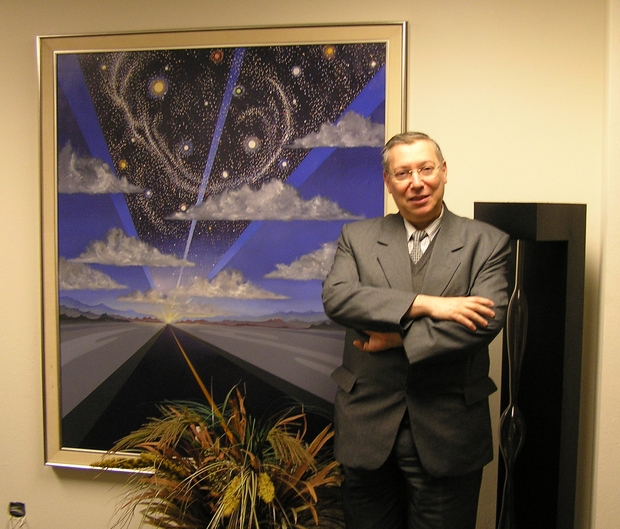
Image: I took this photo of Claudio in Austin, TX in 2009. More on that gathering below.
With degrees in both physics and mathematics from the University of Turin, Claudio received his PhD at King’s College London in 1980. His work on spacecraft design began in 1985, when he joined the Space Systems Group of Alenia Spazio, now Thales Alenia Space Italia, which is where he began to develop ideas ranging from scientific uses for the lunar farside, SETI detections and signal processing, space missions involving sail concepts and, most significantly, a mission to the solar gravitational lens, which is how he and I first connected in 2003.
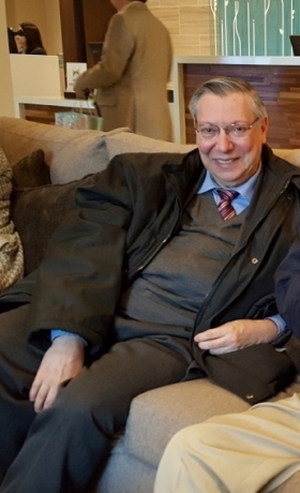
Coming into the community of deep space scientists as an outsider, a writer whose academic expertise was in far different subjects, I always appreciated the help I received early on from people who were exploring how we might overcome the vast distances between the stars. I had written about Claudio’s ideas on gravitational lensing and the kind of mission that might use it for observation of exoplanets, but was startled to find him waiting at breakfast one morning in Princeton, where Greg Matloff had invited me up for a conference.
Image: At one of the Breakthrough Starshot meetings not long after the project was announced. I took this in the lobby of our hotel in Palo Alto.
Ever the gentleman, Claudio wanted to thank me for my discussion of his work in my Centauri Dreams book, and that breakfast with Greg, his wife C, and Claudio remains a bright memory. As is the conference, chaired by Ed Belbruno, where I made many contacts talking to scientists about their work. I was already writing this site, which began in 2004, and over the years that followed, I would run into Claudio again and again, and not always at major conferences. He appeared, for example, at a founding session of what would grow into the Interstellar Research Group in Oak Ridge, quite a hike from Italy, but when it came to interstellar ideas, Claudio always wanted to be there.
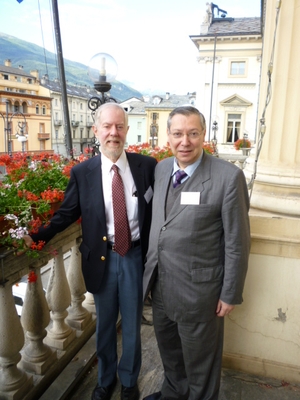
One memorable trip was at Aosta in the Italian Alps, a meeting I particularly cherish because of our meals discussing local history as much as spaceflight. Several of the participants at the Aosta conference had brought their families, and one young boy was fascinated with something Claudio said one night at dinner about Italian history. I’ll never forget his asking Claudio if he could explain what had happened in the Thirty Years War. Claudio didn’t miss a beat. He began talking and in about fifteen minutes had laid out the causes of the conflict between Protestants and Catholics in 17th Century Europe within the context of the Holy Roman Empire, complete with names, dates and details.
I asked him afterwards if he had ever considered a career in history, and it turned out that we both shared an interest especially in Greek and Latin, and that yes, the subject appealed to him, whether it was 17th Century political evolution or the fine points of Pericles’ Funeral Oration. But here he voiced a caution. “You can’t do everything. You just can’t. You have to give so many things up to do your work.” True, of course, and yet somehow his knowledge was that of a polymath. He schooled me on Leibniz over wine and Beef Wellington one night in Dallas, a conversation that went on until late in the evening. In the Italian Alps, he took me into the history of Anselm of Canterbury, who had been born in Aosta, and explained the significance of his philosophy.
Mostly, of course, we talked about space. His fascination with SETI was obvious, and his work on the mathematics of first contact brought the Kosambi–Karhunen–Loève (KLT) theorem into play as a signal processing solution. His work on gravitational lensing and the mission he called FOCAL put that concept in the spotlight, paving the way for later approaches that could solve some of the problems he had identified. A look through the archives here will reveal dozens of articles I’ve written on this and other aspects of his work.
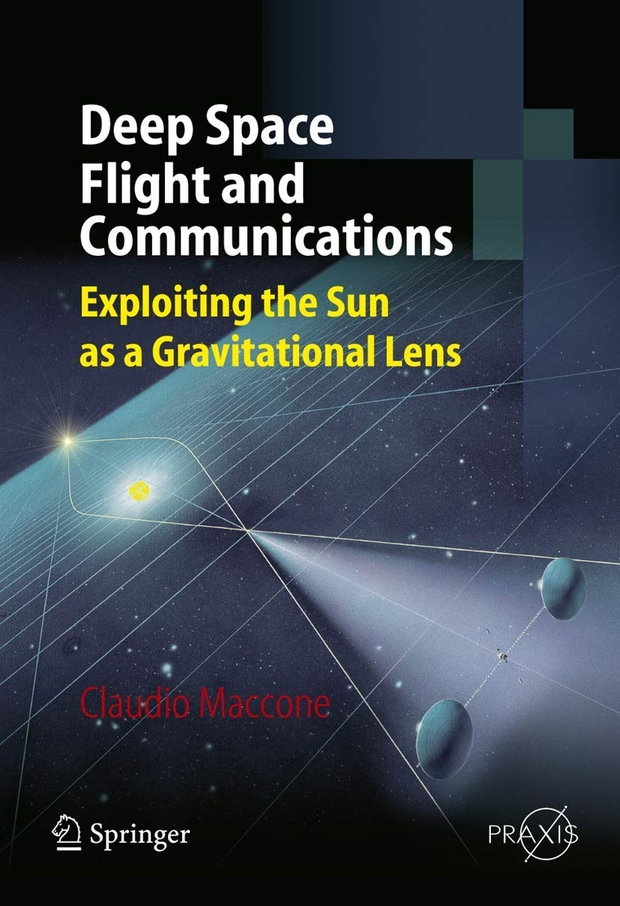
Version 1.0.0
I won’t go into the technical details here – this is a time for recollection more than analysis. But I need to mention that Claudio served as Technical Director for Scientific Space Exploration at the International Academy of Astronautics, a post of which he was rightly proud. Over 100 scientific papers bear his name, as do a number of books, the most influential being Mathematical SETI (2012) and Deep Space Flight and Communications (2009). His ongoing efforts to preserve the lunar farside for astronomical observations remind us of how precious this resource should be in our thinking. Toward the end of his life, he put his mathematical skills to work on the evolution of cultures on Earth and asked whether what he called Evo-SETI could be developed as a way to predict the likelihood of civilizations including our own surviving.
Claudio’s death caused a ripple of comment from people who had worked with him over the years. Greg Matloff, a close friend and colleague, wrote this:
I met Claudio during a Milan solar sail symposium in 1990. We collaborated for years on sails to the solar gravity focus. He was instrumental in my guest professorship in Siena in summer 1994 and my election to IAA. I knew that his health had become a challenge. Apparently, a book shelf had collapsed and he was pinned overnight until his student found him the following morning. I will miss Claudio forever but am glad that I saw him in Luxembourg last December.
I only wish I could have seen Claudio one more time, but it was not to be. I will always honor this good man and thank him for his generosity of spirit, his engaging humor and his willingness to bring me up to speed on concepts that, early on, I found quite a stretch. Now that the concept of a gravitational lensing mission is widespread in the literature and superb work continues at the Jet Propulsion Laboratory on completely new technologies to make this happen, I think Claudio’s place in the history of the interstellar idea is guaranteed.
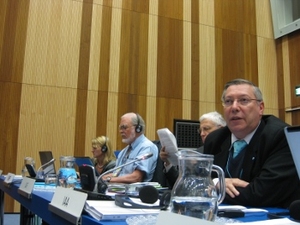
Image: Claudio Maccone speaking before the United Nations Committee on the Peaceful Uses of Outer Space in Vienna 2010. He was proposing a radio-quiet zone on the farside that will guarantee radio astronomy and SETI a defined area in which human radio interference is impossible. It’s an idea with a pedigree, going back to 1994, when the French radio astronomer Jean Heidmann first proposed a SETI observatory in the farside Saha Crater with a link to the nearside Mare Smythii plain and thence to Earth. Credit: COPUOS.
A final happy memory. Claudio and I had met in Austin Texas and were headed to the Institute for Advanced Studies Austin, to meet with Marc Millis, Eric Davis and Hal Puthoff, among others. Claudio had just bought a new laptop so powerful that it could handle the kind of equations he threw at it. On the way, he bragged about it and showed it to me with delight all over his face.
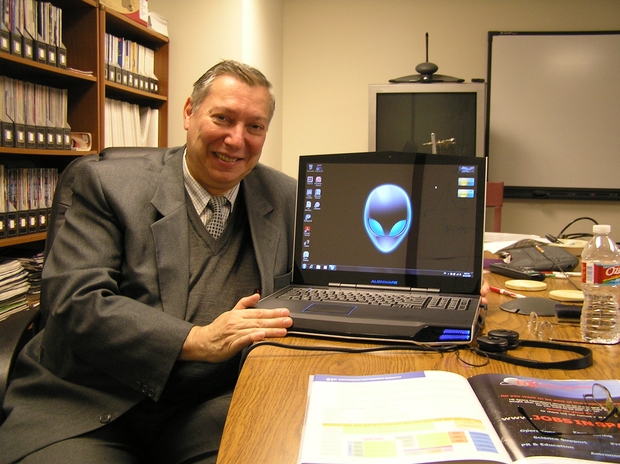
But the joke was that with facial recognition, it refused to recognize him despite his protracted training of the gadget. I can still hear his normally calm voice gradually growing in volume (the meeting had already started and everyone was taking notes), until finally he burst out with “It’s me, damn you!” We all guffawed, and a few seconds later, amazingly, the computer let him in.
Claudio loved Latin, so here’s a bit from Seneca:
Non est ad astra mollis e terris via.
Which means “There is no easy way from the earth to the stars.”
He certainly would have agreed with that statement, but Claudio Maccone did everything in his power to tackle the problem and show us the possibilities that lay beyond our current technologies. His work was truly a gift to our future.

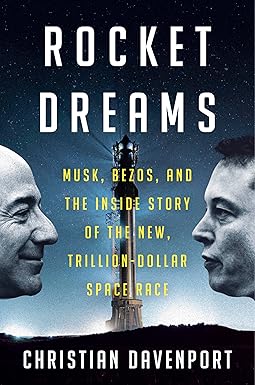

I first met Claudio in 2007 when I organised a conference on warp drive in London. He gave a talk about the importance of developing GR tensor codes for warp drive applications. He also featured in a documentary we had organised with Christian Darkin called ‘Going to the Stars’. I met him many times over the years, typically at IAC conferences in Europe or interstellar related meetings in the US and we had many dinners and toured a few museums together wearing his trade mark suits.
I recall after the TAU project had ended Claudio had shown great diligence in making photocopies of all the papers and he sent ten copies out to everyone to ensure the papers were preserved for any future projects. When I entered the scene I managed to borrow Greg Madoff’s copy and then when I got involved with the JHAPL Interstellar Probe project to 1,000 AU I shared all those papers with them; some they had seen but not all. Claudio understood that interstellar flight, and the exploration of space in general, was a multi-generational effort.
I always found Claudio to be a complete gentlemen and I enjoyed his company. His public lectures were also thoughtful and had a good balance of being scientifically rigorous but also edgy speculative. I recall one talk he gave at the IAC SETI session in Bremen on the validity of using the age of Earth based civilizations (Roman, Greek, British, Spanish…..) as a basis for deriving distribution functions for ETI civilizations. I was critical of his approach, but he defended his arguments and I still found his results interesting and thought provoking. He was never shy of scrutiny.
Claudio may be done in physical form, but like those that went before him, Robert Forward, Carl Sagan, Freeman Dyson….he will take his name as one of the legends that helped to pioneer our field and also to give it the vital air of professionalism that it needed given its proximity to ideas from science fiction.
He will be missed, but not forgotten, and his spirit lives on. Future generations will read his books and papers, and just like a quantum tunnelled state, his ideas will reach outside of his physical existence and continue to influence those that came after. The rest of us can only hope for such a legacy. Good by my friend.
Addio e che Dio ti benedica
A giant may have fallen silent but the echoes of his thoughts on space will be used to see further than human kind has ever seen before.
RIP Dr Maccone, one of the great interstellar thinkers.
I am always amazed to discover these personalities (with a capital P) even though we are neighbors with Italy. Professor Maccone came to France, but he remains unknown to the general public here…
Here we see him during a conference in English :
https://www.youtube.com/watch?v=iB6d27oLAnc&list=PLH9EZ78mjCpNj0WTYWr-GSvL-3_jmaVLQ&index=5
Men pass away, but their ideas remain.
Gracie mille Professore !
Circa 2015, Claudio was the person I reached out to with my SETI animations and he almost immediately replied enthusiastically. Out of the blue a couple days later, Geoff Marcy wrote with encouraging words.
These responses culminated in a 2016 Centauri Dreams article and a 2017 workshop at TVIW (as it was known back then) of which this “Citizen Scientist” is very proud.
What a gentleman and a scholar; and I’m sure a gravitational lens in in humanities future.
RIP Claudio
I LOLed at that final anecdote, great stuff. RIP and thank you Signor.
It would be possible to collect all his papers and correspondence, and anecdotes and biography about him, and use that, together with ongoing feeds of all relevant science papers, to generate an “AI memorial”, complete with an online presence; maybe even a human avatar following his manner of speaking and preferences in fashion. I’m not sure what I think of the idea, but it could be interesting to observe the outcome.
The idea is interesting, but I think there would be copyright issues to resolve first. Would [European] legislation allow it? It’s possible. We’ve already seen shows and computer-generated images bring singers back to life…
Do we really need to go so far as to create an avatar of the man – with no disrespect intended towards Dr. Maccone. If there are going to be legal roadblocks just to obtain his written works into one place, making a functioning hologram of his visage on top of things might complicate matters to the point where we lose access to all of his works. I also do not see how this avatar would really improve upon Dr. Maccone intellectual output – again, with no disrespect intended towards him.
Let us not get carried away here and lose the whole plan in the process.
I asked an AI (natch) and apparently there are compatible projects: https://heterotopia.gr/news/memorial-avatars-ai-influencers-and-the-future-of-1st-person-interpretation/ (But it is true that if I’m going to daydream about sophisticated sci-fi projects, I’m going to daydream of doing them on some fortunate isle where remunerative ethics and the institution of copyright have been despatched with fire and sword…)
I have a pleasant memory, too. I had read an article of his about wormholes, in the Journal of the British Interplanetary Society, from 1998. I didn’t fully understand it, and I was inspired to write to him about it, and he wrote back a nice note clarifying it. Thank you.
He always answered such queries, and was willing to devote as much time as needed to students and readers of his work. I benefited from his generosity over and over again.